
Microtis, commonly known as onion orchids or mignonette orchids is a genus of about 20 species of plants in the orchid family, Orchidaceae. Onion orchids are terrestrial herbs with a single leaf at the base of the plant. They are similar to orchids in the genus Prasophyllum in that they have an onion-like leaf. The flowers are small but often scented and attractive to their insect pollinators. They are widespread in Asia, Australia and some Pacific islands.

Scholtzia is a genus of flowering plants in the family Myrtaceae, which are endemic to the south-west of Western Australia. The genus was first described by Schauer in 1843, who named it in honour of the physician Heinrich Scholtz. The type species is Scholtzia obovata.
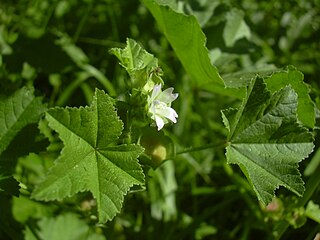
Malva parviflora is an annual or perennial herb that is native to Northern Africa, Europe and Asia and is widely naturalised elsewhere. Common names include cheeseweed, cheeseweed mallow, Egyptian mallow, least mallow, little mallow, mallow, marshmallow, small-flowered mallow, small-flowered marshmallow and smallflower mallow. M. parviflora leaf extracts possess anti-inflammatory and antioxidant activities. It has a decumbent or erect habit, growing up to 50 cm in height. The broad leaves have 5 to 7 lobes and are 8 to 10 cm in diameter. It has small white or pink flowers with 4 to 6 mm long petals.

Synaphea is a genus of small shrubs and is endemic to Western Australia. Synapheas have variably shaped leaves but consistently yellow flowers with an unusual pollination mechanism.
Plantago debilis is a species of herb native to Australia. Common names include shade plantain and weak plantain.

Grevillea gariwerdensis is a species of the plant genus Grevillea. It is endemic to Victoria in Australia. The species grows as a low, suckering shrub, between 0.3 and 1 metre in height. Flowers usually appear between October and January in its native range. These have perianths and styles which are white to pink. It is very similar in appearance to both Grevillea micrantha and Grevillea parviflora. The name Grevillea linearifolia has been misapplied to this species in the past.

Caesia parviflora, the pale grass lily, is a species of flowering plant in the family Asphodelaceae, subfamily Hemerocallidoideae, native to Australia, being found in New South Wales, Queensland, Victoria, Tasmania, South Australia and Western Australia.
Grevillea parviflora is a shrub species in the family Proteaceae. It is native to the state of New South Wales in Australia. There are two subspecies:
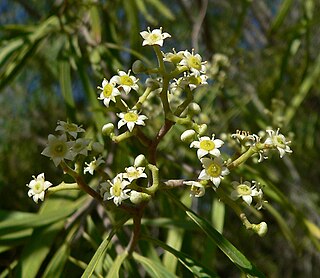
Geijera parviflora, commonly known as wilga, is a species of shrub or small tree in the family Rutaceae and is endemic to inland parts of eastern Australia. It has drooping branches, linear to narrow lance-shaped leaves, small white flowers in loose panicles and spherical fruit containing a shiny black seed. Other vernacular names include Australian willow, native willow, sheepbush and dogwood.

Bruguiera parviflora is a tree in the family Rhizophoraceae. The specific epithet parviflora is from the Latin meaning "small flowers".

Chloanthes is a genus of the Lamiaceae, or mint family, first described in 1810. The entire genus is endemic to Australia.
Agoseris parviflora is a North American species of flowering plants in the daisy family known by the common name Steppe agoseris or sagebrush agoseris or false dandelion. It is found in the Western United States primarily in the Great Basin and the region drained by the Colorado River but also in the eastern foothills of the Sierra Nevada and on the western edge of the Great Plains. Its range extends from eastern Oregon and eastern California to Wyoming, Colorado, and New Mexico, with a few isolated populations in western Kansas and western South Dakota.
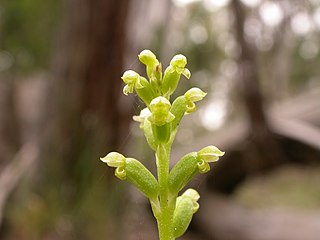
Microtis parviflora, commonly known as the slender onion-orchid, is a species of orchid which is native to Australia and New Zealand. It occurs in all states of Australia but is not known from the Northern Territory and may not occur in Western Australia. As with others in the genus, it has a single erect, smooth, tubular leaf and up to eighty flowers on an erect flower spike.
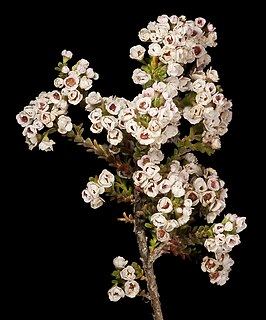
Scholtzia parviflora is a shrub species in the family Myrtaceae that is endemic to Western Australia.
Synaphea parviflora is a shrub endemic to Western Australia.

Ericomyrtus is a genus of shrubs, in the family Myrtaceae, all of which are endemic to Australia.
Ericomyrtus drummondii is a shrub endemic to Western Australia.
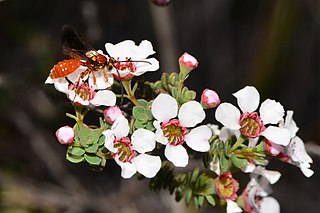
Ericomyrtus serpyllifolia is a shrub endemic to Western Australia.
Ericomyrtus tenuior is a shrub endemic to Western Australia.

Boronia parviflora, commonly known as the swamp boronia, small boronia, tiny boronia, or small-flowered boronia, is a plant in the citrus family Rutaceae and is endemic south-eastern Australia. It is a weak, low shrub with elliptic to egg-shaped leaves with finely toothed edges and up to three pink, white or green four-petalled flowers arranged at or near the ends of the stems.













